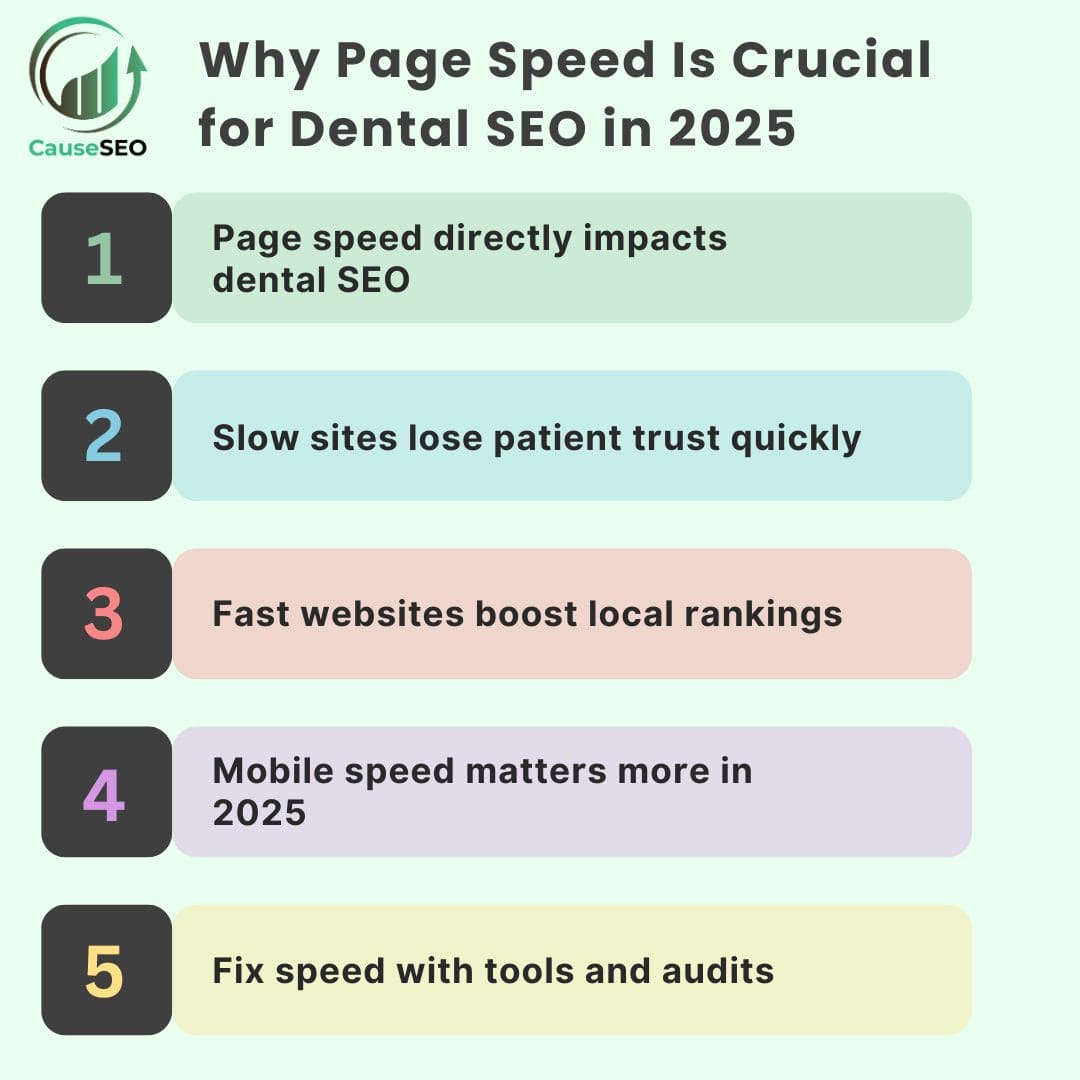Imagine a potential patient searching for a dentist on their phone. They click your website but wait… and wait. Before the page even finishes loading, they hit the back button and choose another clinic. In a digital world shaped by fast decisions and faster expectations, page speed can make or break your visibility. Dental SEO in 2025 depends heavily on how quickly your site responds. Google now treats speed as a ranking factor, and patients expect smooth, instant access—especially on mobile.
In this article, we will explain why page speed matters more than ever, how it shapes patient behavior, and how it affects your SEO for dental practices. We will also cover the most common speed issues on dental sites and what you can do to fix them. Whether you manage your own site or work with a dental SEO expert, these insights will help you stay competitive.

What Is Page Speed and Why It Matters in SEO
Understanding Page Speed
Page speed refers to how quickly a single web page loads. It is not the same as site speed, which is the average speed across all pages of a website. There is also a difference between perceived speed and actual speed. A page might technically load in three seconds, but if content shifts around or buttons do not work right away, users feel like it is slower.
Google’s Core Web Vitals and Ranking Signals
Google uses specific metrics called Core Web Vitals to measure how well a website performs. These include:
- Largest Contentful Paint (LCP): Measures how fast the main content shows up.
- First Input Delay (FID): Tracks how quickly the page responds to user input.
- Cumulative Layout Shift (CLS): Checks for visual stability during loading.
These metrics help Google decide which sites offer a good experience. Speed is now a confirmed ranking factor, especially for SEO on mobile devices.
How Page Speed Affects Dental Website Performance
User Behavior and Bounce Rate
When people visit a slow website, many leave before the page finishes loading. This is known as a high bounce rate. For a dental office, that means fewer patients are reading about your services, filling out forms, or calling your clinic. A slow site makes a poor first impression and can cause potential patients to lose trust.
Mobile Experience Matters More in 2025
Most users now search for dental care on their phones. Mobile-first indexing means Google evaluates the mobile version of your site first when ranking it. If your mobile page loads slowly, you are losing both rankings and mobile visitors. This is especially important for people searching during dental emergencies who need immediate help.
Conversion Rates and Appointment Bookings
Studies show that even a one-second delay in loading can reduce conversions by 20 percent. When your site loads quickly, visitors are more likely to click on appointment buttons, fill out contact forms, or call your practice. A fast website means more action and more patients.
Real-World Impact on Dental SEO Rankings
Speed and Search Visibility
Websites that load faster rank higher in Google search results. This is especially true for local searches. If someone types in “emergency dentist near me,” Google prefers to show websites that respond quickly and are easy to use. For competitive keywords, speed often makes the difference between being on the first page or not being found at all.
Local SEO and Page Speed
In local dental SEO, page speed affects how you appear in the local pack and Google Maps listings. A faster site helps you stand out among nearby competitors. In 2025, many dental offices have similar services and websites. Speed gives your practice an edge in local search.

Common Page Speed Issues Found on Dental Sites
Heavy Media (Images and Videos)
Dental websites often include high-resolution images of treatments or video content explaining procedures. While these help educate visitors, they can also slow down your site. You can improve speed by compressing images, using modern formats like WebP, and enabling lazy loading so media loads only when needed.
Bloated Code and Outdated Platforms
Some dental websites use outdated platforms or too many plugins, especially on WordPress. This can result in bloated code that takes longer to load. Problems like unused JavaScript, render-blocking CSS, and third-party scripts can all hurt performance. Cleaning up code and updating your system can lead to noticeable improvements.
Hosting and Server Delays
If your website uses cheap shared hosting, it is likely to be slow. A better solution is using dental-specific hosting or a content delivery network (CDN) like Cloudflare or BunnyCDN. These services help your site load faster for visitors in different locations.
How to Improve Page Speed for Dental SEO
Technical Fixes
There are several technical steps that improve load times. These include minifying code (HTML, CSS, JavaScript), enabling Gzip compression, reducing redirects, and removing broken or slow-loading scripts. These changes can speed up your website without changing how it looks.
Tools to Measure and Monitor Speed
Use these tools to test your site:
- Google PageSpeed Insights
- GTmetrix
- Lighthouse (built into Chrome DevTools)
These tools give performance scores and suggestions. Aim for a PageSpeed score of 90 or above and a load time of under 2.5 seconds for best results.

Best Practices for Ongoing Performance
Improving page speed is not a one-time job. Schedule regular performance checks, update plugins and themes, and compress new images before uploading. Monitor Core Web Vitals regularly to catch slowdowns before they hurt your rankings.
FAQs About Page Speed and Dental SEO
What is a good page speed score for dental websites in 2025?
A score of 90 or higher on PageSpeed Insights is ideal. Your page should load in under 2.5 seconds on both mobile and desktop devices.
Can a slow dental site still rank well?
It is rare. In competitive cities or markets, speed plays a major role. Google now gives priority to websites that load quickly and perform well on mobile.
Do Core Web Vitals really matter for SEO?
Yes, they are officially part of Google’s ranking system. Sites that meet Core Web Vitals perform better in search and provide a better user experience.
Is fixing page speed expensive?
Not always. Many improvements, such as compressing images or switching to better hosting, are affordable and offer a strong return.
Will improving page speed increase patient leads?
Yes. Faster websites reduce bounce rates, increase trust, and lead to more appointment bookings.
Conclusion
Page speed is now one of the most important factors in dental SEO. A slow website not only loses search rankings but also pushes away potential patients. In 2025, fast websites stand out, get found, and convert better.
Google continues to reward performance, especially on mobile. That means site speed will matter even more in the future. Dental practices that invest in speed today are setting themselves up for better visibility and more patient growth tomorrow.
If your dental website is slow, now is the time to act. Visit CauseSEO and let our dental SEO experts help you improve your page speed and stay ahead in local search.

